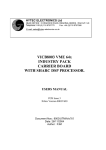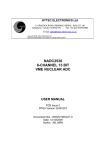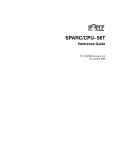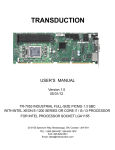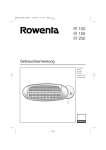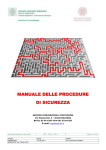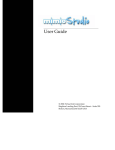Download User Manual - Hytec Electronics Ltd
Transcript
HYTEC ELECTRONICS Ltd 5 CRADOCK ROAD, READING, BERKS. RG2 0JT, UK Telephone: +44 (0) 118 9757770 Fax: +44 (0)118 9757566 E-mail: [email protected] Copyright 2008, Hytec Electronics Ltd Data and specifications are subject to change without notice VCB8004 VME 64x INDUSTRY PACK CARRIER BOARD USERS MANUAL PCB Issue 1.0 Xilinx Version 8004V101 Document Nos.: 8004/UTM/G/x/1.0 Date: 29/02/2008 Author: MRN Hytec Electronics Ltd 8004/UTM/G/2/1.0 CONTENTS 1. PRODUCT DESCRIPTION......................................................................................................................................3 1.1 2. KEY FEATURES .....................................................................................................................................................4 USE OF THE VME DATA BUS AND MEMORY ACCESS.................................................................................5 2.1 VME ADDRESSING ...............................................................................................................................................5 2.1.1 Short Addressing (A16 AM29h and 2Dh)........................................................................................................5 2.1.2 Standard Addressing (A24 AM39h and 3Dh)..................................................................................................6 2.1.3 Carrier board Configuration ROM (A24 AM2Fh).........................................................................................6 2.2 MEMORY ACCESS .................................................................................................................................................6 2.2.1 IP Memory Size................................................................................................................................................6 2.2.2 Carrier Board IP Memory Map ......................................................................................................................7 2.2.3 Extended Addressing (A32 AM08, AM0C AM09, AM0D, AM0B and AM0F) ................................................7 3. ON BOARD FEATURES ..........................................................................................................................................7 3.1 IP STATUS REGISTER (READ ONLY).....................................................................................................................7 3.2 MEMORY OFFSET (READ/WRITE) ........................................................................................................................7 3.3 CONTROL & STATUS REGISTER CARRIER BOARD (CSR CB)................................................................................8 3.4 IP INTERRUPT SELECT REGISTER (READ/WRITE).................................................................................................8 3.5 VME SYSTEM AND BOARD RESETS ......................................................................................................................9 3.5.1 A VME system reset will clear the following registers:...................................................................................9 3.5.2 A board reset generated from the CSR CB bit 0 will clear the following registers: .......................................9 4. INTERRUPT SETTINGS..........................................................................................................................................9 5. MEMORY 32BIT OR 64BIT DATA TRANSFERS .............................................................................................10 6. VME64X KEYING AND ALIGNMENT PINS .....................................................................................................10 APPENDIX A PCB JUMPERS....................................................................................................................................11 APPENDIX B CARRIER BOARD CONFIGURATION ROM ................................................................................12 APPENDIX C ID PROM REGISTERS (GREENSPRING FORMAT) .....................................................................13 PRODUCT SPECIFICATIONS ......................................................................................................................................14 VME64X PIN ASSIGNMENTS.......................................................................................................................................15 Page 2 of 16 Hytec Electronics Ltd 8004/UTM/G/3/1.0 1. PRODUCT DESCRIPTION The VCB 8004 is a 6U (double height) VME board constructed to the VME64x standard, with EMC front panel, injector/ejector handles, guide pin and slot keying, static discharge protection, hot swap capability, blue power up LED, geographical or jumper selected addressing, 5-row P1 and P2 connectors and 5-row P0 connector. The module features hot-swap capability with auto power up and host interaction. An on-board FPGA allows full mapping of the IP board memory, I/O and ID spaces. The VME interface supports short I/O access A16: D16:D08 (EO), standard I/O access A24:D16:D08 (EO) and extended memory access A32: D64: D32: D16. The module also has the ability to carry out MBLT A32 D64 and BLT A32:D32:D16 data transfers on IP memory space. Four Industry Pack sites are available and can accept 4 single-size Industry Packs. The board has the capability to multiple-address the memory of IP sites and read/write data to them simultaneously using a data width of 32 or 64 bits. The carrier board supports 8MHz and 32MHz IP interfaces. One of VMEbus interrupt lines IRQ1 to IRQ7 can be selected and enabled by writing to an on-board register. The Industry Pack interrupt lines IntReq0* and IntReq1* from each of the four sites can be enabled on an individual basis and mapped to the selected VME IRQ line. Four front panel mounted LED’s flash to visually confirm completed IP access cycles to individual slots. There is a TTL ‘Inhibit’ input on the front panel that allows connection to any or all of the IP card Strobe* lines through jumpers. The signal is routed through this pin on the IP logic connector to allow overall control to be applied to IP boards in data acquisition systems. The ‘GO’ output can be connected to the ‘Inhibit’ input through a jumper to synchronise timing between carrier boards. The carrier board has some thickened I/O tracks to allow the IP boards to be powered externally to give full isolation. All I/O is via the VME backplane P0 and P2 connectors as specified in the VME64 extensions specification. The signals connect to the industry pack sites according to the VME64x Greenspring pinout for IP module carriers. Hytec has a number of rear-mounted transition cards with high-density 50-way [SCSI2] connectors, which can cater for all 200 IP I/O signals and provide any necessary signal conditioning. Page 3 of 16 Hytec Electronics Ltd 8004/UTM/G/4/1.0 1.1 Key Features • VME64 extensions / Industry Pack Carrier Board • VME64x rear panel I/O • Base Address decoding by either Geographical addressing or jumper selectable • IP memory space accesses software configurable from 1Mbyte to 8Mbytes • MBLT D64 operation for simultaneous memory data access to all four IP sites • BLT or Single D32 operation for simultaneous memory data access to two IP sites • BLT or Single D16 operation for memory data access to one IP site • IP module Clock speeds can be individually selected to be 8MHz or 32MHz by software. • Full EMC shielding and insertion/extraction handles • Fully Hot-Swap capable with auto power-up and host interaction • 6U (double height) VME base card • User selectable VME interrupt level via software programmable registers • Up to two interrupt requests are supported for each IP module • Interrupt release mechanism RORA or ROAK software selectable • Front panel TTL Go/Inhibit signals allow control of IP timing synchronisation • Thickened I/O lines to allow externally power supply to IPs • VME 64x Configuration ROM • On-board 32MHz clock generation • VME64x guide pin and slot keying • 3.3V and 5V supply to P2 connector • Self-resetting PTC fuses on all the IP power supplies Page 4 of 16 Hytec Electronics Ltd 8004/UTM/G/5/1.0 2. USE OF THE VME DATA BUS AND MEMORY ACCESS 2.1 VME Addressing The module uses A16/D16/D08 (EO) (Even and Odd byte3) or A24/D16/D08 (EO) for accesses to the IP I/O, IP ID and Carrier board Configuration Registers. The base address of these areas are set either by PCB jumpers (J6 to J10) or by VME64x geographical addressing lines GA0 to GA4. Address I/O Base+ Offset 0x0000 I/O Base+ 0x0080 I/O Base+ 0x0100 I/O Base+ 0x0180 I/O Base+ 0x0200 I/O Base+ 0x0280 I/O Base+ 0x0300 I/O Base+ 0x0380 I/O Base+ 0x0400 I/O Base + 0x0420 I/O Base + 0x0440 I/O Base+ 0x0480 I/O Base+ 0x0600 Range Assignment 0x0000 IP A I/O Space 0x007E 0x0080 IP A ID Space 0x00FE 0x0100 IP B I/O Space 0x017E 0x0180 IP B ID Space 0x01FE 0x0200 IP C I/O Space 0x027E 0x0280 IP C ID Space 0x02FE 0x0300 IP D I/O Space 0x037E 0x0380 IP D ID Space 0x03FE 0x0400 Carrier on board registers 0x041E 0x0420 SHARC Control Registers 0x043E (option) 0x0440 Dual-Ported SRAM accessible 0x047E from VME and SHARC (option) 0x0480 Green Springs Type ID 0x04FF 0x0600 VME64x configuration ROM 0x07FF (See appendix B) 8004 A16 and A24 address Map Size 128 Bytes 128 Bytes 128 Bytes 128 Bytes 128 Bytes 128 Bytes 128 Bytes 128 Bytes 32 Bytes 32 Bytes 64 Bytes 128 Bytes 512 Bytes 2.1.1 Short Addressing (A16 AM29h and 2Dh) In Short address mode the geographical addressing lines equate to the address lines GA0 =A11 to GA4=A15 and the jumper address setting J6=A11 to J10=A15. A11 - A15 is the module address determined by the setting of the relevant PCB jumpers or geographical address lines IP I/O, IP ID and Carrier board Configuration Registers: AM29 Short (A16) non-privileged. AM2D Short (A16) supervisory. Page 5 of 16 Hytec Electronics Ltd 8004/UTM/G/6/1.0 2.1.2 Standard Addressing (A24 AM39h and 3Dh) The A24 base address is determined either by PCB jumper settings J6=A19 to J10=A23 or by geographical addressing lines GA0 =A19 to GA4=A23. IP I/O, IP ID and Carrier board Configuration Registers: AM39 Standard (A24) non-privileged. AM3D Standard (A24) supervisory. 2.1.3 Carrier board Configuration ROM (A24 AM2Fh) See appendix B for the contents of the configuration ROM. AM2F Configuration ROM/Control & Status Registers. Address selection as above 2.2 Memory Access The module uses A32/D64/D32/D16 for accesses to the IP memory. The base address of the memory can be set by either the Geographical address lines/Manual jumpers or by using the Memory Offset Register. Writing a ‘1’ to bit ‘6’ of the CSR CB (base+8h) selects the Memory Offset Register to set the base address. Using the Memory Offset Register to store the base address allows the address lines A22 to A31 to be used to set the base address. Geographical addressing uses the lines GA0=A22 to GA4=A26. First need to select whether Geographical address lines or the Memory Offset register are to define the extended memory start address. This is selected using MEM MODE (bit 6) of the CSR CB register. MEM MODE (bit 6 CSR ) 0 1 Memory Addressing Mode Geographical address lines Memory Offset register Bit 6 CSR CB setting the memory address mode 2.2.1 IP Memory Size Some controllers have a limited memory range so to take account of this when using geographical and register addressing the memory size allocated to each IP card can be controlled:CSR CB IPMS1 IPMS0 (bit 8) (bit 7) 0 0 0 1 1 0 1 1 IP Memory Size 1MB 2MB 4MB 8MB Address Lines Geographical Memory Offset Addressing Reg A22-A26 A22-A31 A23-A26 A23-A31 N/A A24-A31 A27-A31 A25-A31 Here the GA address is shifted up one. This only allows 16 slots to be used with geographical Addressing 2.2.2 Carrier Board IP Memory Map Address Memory Range Page 6 of 16 Memory Hytec Electronics Ltd Memory Base + Memory Base + Memory Base + Memory Base + 8004/UTM/G/7/1.0 1MB 0x000000 0x0FFFFF 0x100000 0x1FFFFF 0x200000 0x2FFFFF 0x300000 0x3FFFFF 2MB 0x000000 0x1FFFFF 0x200000 0x3FFFFF 0x400000 0x5FFFFF 0x600000 0x6FFFFF 4MB 0x000000 0x3FFFFF 0x400000 0x7FFFFF 0x800000 0xBFFFFF 0xC00000 0xFFFFFF 8MB 0x000000 0x7FFFFF 0x800000 0xFFFFFF 0x1000000 0x17FFFFF 0x1800000 0x1FFFFFF Assignment IP A IP B IP C IP D 2.2.3 Extended Addressing (A32 AM08, AM0C AM09, AM0D, AM0B and AM0F) A32 Memory Address Modifiers: Single - AM09 or AM0D (extended non-priv. or supervisory) BLT - AM0B or AM0F (extended non-priv. or supervisory) MBLT - AM08 or AM0C (extended non-priv. or supervisory) 64 bit block transfer. 3. ON BOARD FEATURES The configuration and control of the 8004 module is achieved by the following registers: Base Base + Base + Base + Base + Base + Offset 0x400 0x404 0x408 0x40C 0x410 3.1 Register Description IP Status Allows state of IP INT and Error flags to be monitored Memory Offset Sets base address of IP memory areas Control & Status Register CB Set up of 8004 carrier card IP Interrupt Select Selects IP interrupts to be mapped to VME IRQ Not Use None 8004 On-Board Registers IP Status Register (Read Only) Address: Read = Base + 0x0400 D15 D14 D13 D12 DMA DMA DMA DMA REQ REQ REQ REQ D0 C0 B0 A0 D11 NU D10 NU D09 NU D08 IP ERR D07 INT REQ D1 D06 INT REQ C1 D05 INT REQ B1 D04 INT REQ A1 D03 INT REQ D0 D02 INT REQ C0 D01 INT REQ B0 D00 INT REQ A0 Two interrupt status, one DMA status (not used) and one error status bits for each of IP sites A – D. IP ERR Open drain signal can be driven by any IP card. The Industrial I/O Pack specification states that the error signals indicate a non-recoverable error from the IP module. See your IP documentation for a description of the error signal if used. 3.2 Memory Offset (Read/Write) Address: Base + 0x0404 D15 A31 D14 A30 D13 A29 D12 A28 D11 A27 D10 A26 D09 A25 D08 A24 D07 A23 D06 A22 D05 x D04 x D03 x D02 x D01 x D00 x ‘x’ = don’t care This register defines the IP memory base address when selected by MEMMODE=’1’ in CSR CB. Page 7 of 16 Hytec Electronics Ltd 8004/UTM/G/8/1.0 3.3 Control & Status Register Carrier Board (CSR CB) Control (Write) Address: Base + 0x0408 D15 D14 AB 32Bit CD 32Bit D13 IP D CLK D12 IP C CLK D11 IP B CLK D10 D09 D08 D07 D06 D05 D04 D03 D02 D01 D00 IP A INT IPMS IPMS MEM IPCLK INTSEL INTSEL INTSEL INTEN Rst CLK RELS 1 0 MODE SEL 2 1 0 Status (Read) Address: Base + 0x0408 D15 D14 AB 32Bit CD 32Bit D13 IP D CLK D12 IP C CLK D11 IP B CLK D10 D09 D08 D07 D06 D05 D04 D03 D02 D01 D00 IP A INT IPMS IPMS MEM IPCLK INTSEL INTSEL INTSEL INTEN Rst CLK RELS 1 0 MODE SEL 2 1 0 Rst INTEN INTSEL0 INTSEL1 INTSEL2 IPCLKSEL MEMMODE IP MS0 IP MS1 INT RELS IP A CLK IP B CLK IP C CLK IP D CLK CD32bit AB32bit Clears status register to zero when written as a ‘1’. Enable interrupt from carrier board to VMEbus backplane. Select VME interrupt level. Select VME interrupt level. (See section 4). Select VME interrupt level. 0= Sel 8MHz IP clock or as set by IP A to D CLK 1=32MHz clock on all sites Select memory base address to be defined by geographical address lines=0 or by Memory offset vector register=1. Set IP memory size. Set IP memory size. (See section 2.2) Interrupt release RORA=0 and ROAK = 1 (see section 4) Set IP A clock speed 0 = 8MHz and 1 = 32MHz (If IPCLKSEL=1 overrides this setting). Set IP B clock speed 0 = 8MHz and 1 = 32MHz (If IPCLKSEL=1 overrides this setting). Set IP C clock speed 0 = 8MHz and 1 = 32MHz (If IPCLKSEL=1 overrides this setting). Set IP D clock speed 0 = 8MHz and 1 = 32MHz (If IPCLKSEL=1 overrides this setting). Enables 32-bit data access to IP sites C&D Enables 32-bit data access to IP sites A&B 3.4 IP Interrupt Select Register (Read/Write) Address: Base + 0x040C D15 NU D14 NU D13 NU D12 NU D11 NU D10 NU D09 NU D08 NU D07 D06 D05 D04 D03 D02 D01 D00 IPINT IPINT IPINT IPINT IPINT IPINT IPINT IPINT D1 C1 B1 A1 D0 C0 B0 A0 This selects which IP interrupt request lines will be enabled. ‘1’ = corresponding IP card interrupt enabled. Page 8 of 16 Hytec Electronics Ltd 8004/UTM/G/9/1.0 3.5 VME System and Board Resets 3.5.1 A VME system reset will clear the following registers: • • • CSR CB Memory Offset Register IP Interrupt Select register 3.5.2 A board reset generated from the CSR CB bit 0 will clear the following registers: • • CSR CB IP Interrupt Select register 4. INTERRUPT SETTINGS The interrupt level generated by the carrier board is set using the CSR CB register INTSEL0 (bit 2), INTSEL1 (bit 3), and INTSEL2 (bit 4). Interrupt Level None IRQ 1 IRQ 2 IRQ 3 IRQ 4 IRQ 5 IRQ 6 IRQ 7 INTSEL 2 INTSEL 1 INTSEL 0 0 0 0 0 0 1 0 1 0 0 1 1 1 0 0 1 0 1 1 1 0 1 1 1 VME Interrupt Level Select The IP Interrupt Select register allows the user to enable only the IP interrupts required and mask off the rest. To select an IP interrupt write a ‘1’ to the appropriate bit of the register see section 3.4 above. The interrupt vector is held on the individual IP cards. To enable VME interrupts from the carrier board to the VMEbus backplane set bit 1 of the CSR CB to ‘1’. Writing a ‘0’ to this register disables the interrupts. The VME interrupt is released by clearing the interrupt enable bit INTEN (bit 1) in the CSR on acknowledge. If bit 9 set to ‘1’ in CSR The VME interrupt is cleared when it is acknowledged [ROAK protocol]. If bit 9 set to ‘0’ in the CSR the interrupt is released when the interrupt service routine clears the interrupt enable bit [RORA protocol]. in the CSR (bit 1 INTEN) . The IP interrupts are prioritised in the 8004 where IP A has the highest and IP D the lowest. Each IP card can be loaded with a separate IP vector and when an interrupt occurs the controller will be given the interrupt vector of the highest priority IP card currently asserting either of its interrupt lines. If all four card interrupt at the same time then IP A will be serviced first then IP B then IP C and finally IP D. Reading the IP Status register of the 8004 at base + 0x0400 (READ ONLY) shows which IP cards have interrupts pending. Page 9 of 16 Hytec Electronics Ltd 8004/UTM/G/10/1.0 5. MEMORY 32BIT OR 64BIT DATA TRANSFERS To carry out a 32bit data transfer set the relevant AB32(bits 15) or CD32(bits 14) bits in the CSR and address the first IP module of the pair i.e. ‘A’ for AB32 and ‘C’ for CD32. There is no need to set AB32 or CD32 for a MBLT data transfer as these are ignored as it is 64 bit only. When doing an MBLT must address IP site ‘A’. When doing a 32bit or 64bit data transfer the clocks for the IP modules involved must be the same either 8MHz or 32MHz as set in the CSR bits 10 to 13. 6. VME64x KEYING AND ALIGNMENT PINS The keying mechanism provides for three key holes on top and three keying holes on the bottom of each board and subrack slot. Each key hole can be keyed with a “No Key” or a keying peg in one of four positions. With three key holes top and bottom the scheme provides a total of 15,625 keying combinations. Page 10 of 16 Hytec Electronics Ltd APPENDIX A 8004/UTM/G/11/1.0 PCB JUMPERS Hytec 8004 IP Carrier Board J1 J2 J3 J4 J5 J6 – J10 J11 J12 J17 Connects the common strobe line from the FPGA to Industry Pack C Logic Connector pin 46. Must be IN Factory set. Connects the common strobe line from the FPGA to Industry Pack A Logic Connector pin 46. Supplies switched and fused +5V to pins P2 A32 and P2 C32 (Delivered Not selected). Connects the common strobe line from the FPGA to Industry Pack B Logic Connector pin 46. Base address:. Make according to required A11-A15 base address short IO addressing or A19 – A23 for A24 Standard addressing Connects the common strobe line from the FPGA to Industry Pack D Logic Connector pin 46. This is Factory set. Selects GO to be driven by either INHIBIT front panel lemo or from FPGA logic in this version of the firmware the FPGA drives GO high. In this version the jumper should be either removed or in the INH position. Note: The reference to the ‘Common Strobe Line’ refers to the front panel Inhibit signal which is passed through by the FPGA unprocessed, thus asserting the Inhibit input low will drive all connected IP logic connector pins 46 (Strobe*) low. J13, J14, ,J15 and J16 Not used in this version. Set Base Address Jumpers J6 – J10 To use VME64 geographical addressing lines all jumpers should be inserted in to position AUTO. To use the user set base address removing all Base address jumpers from positions AUTO and insert the required jumpers in to positions MANUAL. With no jumpers in position MANUAL for J6 to J10 the address is 0x0000 A16 or 0x000000 A24. With one jumpers in position MANUAL for J6 the address is 0x0800 A16 or 0x080000 A24. With all jumpers in position MANUAL for J6 to J10 the address is 0xF800 A16 or 0xF80000 A24. Base Addrs (Hex) A16 0000 0800 1000 1800 : : E000 E800 F000 F800 A24 000000 080000 100000 180000 : : E00000 E80000 F00000 F80000 A15 (Manual) A14 (Manual) A13 (Manual) A12 (Manual) A11 (Manual) OUT OUT OUT OUT : : IN IN IN IN OUT OUT OUT OUT : : IN IN IN IN OUT OUT OUT OUT : : IN IN IN IN OUT OUT IN IN : : OUT OUT IN IN OUT IN OUT IN : : OUT IN OUT IN Page 11 of 16 Hytec Electronics Ltd APPENDIX B 8004/UTM/G/12/1.0 Carrier Board Configuration ROM Address Offset 0x03 0x07 0x0B 0x0F 0x13 0x17 0x1B 0x1F 0x23 0x27 0x2B 0x2F Value C1 00 02 00 Definition Check Sum Length of ID ROM MSB Length of ID ROM Length of ID ROM LSB Configuration ROM data access width 0x83 CSR data access width 0x83 CSR space Specification ID VME64x-1997 0x02 Identify a Valid CR ‘C’ 0x43 ‘R’ 0x52 Manufacturer’s ID 0x00 0x80 0x03 Board ID 0x33 0x37 0x3B 0x3F 0x80 0x04 0x00 0x00 Revision ID 0x43 0x47 0x4B 0x4F 0x01 0x05 0x00 0x01 PCB issue Xilinx version Xilinx revision nos Xilinx revision nos ASCII string null terminated or 0x000000 0x53 0x57 0x5B 0x00 0x00 0x00 Program ID code 0x7F 0x01 No program, ID ROM only Interrupt Capabilities 0xF7 0xFE Denotes support for Int levels 7 – 1. Data Access Width 0x103 0x84 Accepts D32, D16 or D08(EO) cycles Board Serial Number 0xCB, 0xCF, 0xD3 0xD7, 0xDB, 0xDF 0x 0x BEG_SN MSB END_SN LSB 0x123.. 0x13F 0x2200A2000000BB00 AM code mask AM codes 3D, 39, 2F, 2D, 29, 0F, 0D, 0C, 0B, 09, 08 Reading the Configuration ROM using A16 (AM29 and AM2D) or A24 (AM39 and AM3D) the address is VME base address + 0x0600, the Configuration ROM offset. Can read Configuration ROM using A24 AM2F starting at base address + 0x0000. Page 12 of 16 Hytec Electronics Ltd 8004/UTM/G/13/1.0 APPENDIX C ID PROM Registers (GreenSpring Format) Address Offset 0x481 0x483 0x485 0x487 0x489 0x48B 0x48D 0x48F 0x491 0x493 0x495 0x487 Value 0x49 0x50 0x41 0x43 0x80 0x84 0x0x 0x00 0x00 0x00 0x0C Definition ASCII “I” ASCII “P” ASCII “A” ASCII “H” Manufacturer’s ID Model Number Revision Reserved Driver ID, low byte Driver ID, high byte No of bytes used CRC The low four bytes contain the ASCII text “IPAH” this signifies that the 8004 carrier board supports the 8MHz and 32MHz IP interfaces. Page 13 of 16 Hytec Electronics Ltd 8004/UTM/G/14/1.0 PRODUCT SPECIFICATIONS Power Requirements +5V @ 600mA typical +12V @ 30mA -12V @ 30mA +3.3V @ approx 10mA Additional power maybe consumed by Industry Packs. Operating Temperature Range 0 to +45 deg Celsius ambient. Mechanical 6U single width VME module with access to 5 row P0, P1 and P2 connectors. IP Memory Mapping VME Access Single A32:D32, D16, D8 (EO) AM Codes: 09h and 0Dh. VME Access BLT A32:D32, D16, D8 (EO) AM Codes: 0Bh and 0Fh. VME Access MBLT A32:D64 AM Codes: 08h and 0Ch IP I/O Mapping VME Access A16:D16:D8 (EO) AM Codes: 29h and 2Dh. VME Access A24:D16:D8 (EO) AM Codes: 39h and 3Dh. Front Panel Indicators and Inputs ‘VME’ LED (green) ‘Not Configured LED (blue) IP ACK 4 LED’s (red) Illuminates for a minimum of 20msecs whenever the module is accessed via the VME bus. Indicates the state of the VME module during hot swap operation. Indicate when an IP card has sent an ACK. Front Panel Connectors Input to supply common IP sites Inhibit Single TTL input. This input has a 10K pull-up resistor to 3.3Volt supply. Connector type: LEMO ‘00’ Go Single output. This output may be connected by a jumper to the Inhibit input signal for propagation of Inhibit from carrier to carrier. Connector type: LEMO ‘00’ Page 14 of 16 Hytec Electronics Ltd 8004/UTM/G/15/1.0 VME64x PIN ASSIGNMENTS ROW A P0.A01 P0.A02 P0.A03 P0.A04 P0.A05 P0.A06 P0.A07 P0.A08 P0.A09 P0.A10 P0.A11 P0.A12 P0.A13 P0.A14 P0.A15 P0.A16 P0.A17 P0.A18 P0.A19 SIG IODO1 IOD06 IOD11 IOD16 IOD21 IOD26 IOD31 IOD36 IOD41 IOD46 IOC01 IOC06 IOC11 IOC16 IOC21 IOC26 IOC31 IOC36 IOC41 ROW B P0.B01 P0.B02 P0.B03 P0.B04 P0.B05 P0.B06 P0.B07 P0.B08 P0.B09 P0.B10 P0 B11 P0.B12 P0.B13 P0.B14 P0.B15 P0.B16 P0.B17 P0.B18 P0.B19 SIG IOD02 IOD07 IOD12 IOD17 IOD22 IOD27 IOD32 IOD37 IOD42 IOD47 IO002 IO007 IO012 IO017 IOC22 IO027 IO032 IO037 IO042 ROW C P0.C01 P0.C02 P0.C03 P0.C04 P0.C05 P0.C06 P0.C07 P0.C08 P0.C09 P0.C10 P0.C11 P0.C12 P0.C13 P0.C14 P0.C15 P0.C16 P0.C17 P0.C18 P0.C19 SIG IOD03 IOD08 IOD13 IOD18 IOD23 IOD28 IOD33 IOD38 IOD43 IOD48 IOC03 IOC08 IOC13 IOC18 IOC23 IOC28 IOC33 IOC38 IOC43 ROW D P0.DO1 P0.D02 P0.D03 P0.D04 P0.D05 P0.D06 P0.D07 P0.D08 P0.D09 P0.D10 P0.D11 P0.D12 P0.D13 P0.D14 P0.D15 P0.D16 P0.D17 P0.D18 P0.D19 SIG IOD04 IOD09 IOD14 IOD19 IOD24 IOD29 IOD34 IOD39 IOD44 IOD49 IOC04 IOC09 IOC14 IOC19 IOC24 IOC29 IOC34 IOC39 IOC44 ROW E P0.E01 P0.E02 P0.E03 P0.E04 P0.E05 P0.E06 P0.E07 P0.E08 P0.E09 P0.E10 P0 E11 P0.E12 P0.E13 P0.E14 P0.E15 P0.E16 P0.E17 P0.E18 P0.E19 SIG IOD05 IODlO IOD15 IOD20 IOD25 IOD30 IOD35 IOD40 IOD45 IOD50 IOC05 IOC10 IOC15 IOC20 IOC25 IOC30 IOC35 IOC40 IOC45 ROW F P0.F01 P0.F02 P0.F03 P0.F04 P0.F05 P0.F06 P0.F07 P0.F08 P0.F09 P0.F10 P0.F11 P0.F12 P0.F13 P0.F14 P0.F15 P0.F16 P0.F17 P0.F18 P0.F19 SIG GND GND GND GND GND GND GND GND GND GND GND GND GND GND GND GND GND GND GND P0 pin assignments P1 ROW A P1.A01 P1.A02 P1.A03 P1.A04 P1.A05 P1.A06 P1.A07 P1.A08 P1.A09 P1.A10 P1.A11 P1.A12 P1.A13 P1.A14 P1.A15 P1.A16 P1.A17 P1.A18 P1.A19 P1.A20 P1.A21 P1.A22 P1.A23 P1.A24 P1.A25 P1.A26 P1.A27 P1.A28 P1.A29 P1.A30 P1.A31 P1.A32 SIGNAL D00 D01 D02 D03 D04 D05 D06 D07 GND N/C GND DS1* DS0* WRITE GND DTACK* GND AS GND IACK IACKIN* IACKOUT AM4 A07 A06 A05 A04 A03 A02 A0l -12V +5V P1 ROW B P1.B01 P1.B02 P1.B03 P1.B04 P1.B05 P1.B06 P1.B07 P1.B08 P1.B09 P1.B10 P1.B11 P1.B12 P1.B13 P1.B14 P1.B15 P1.B16 P1.B17 P1.B18 P1.B19 P1.B20 P1.B21 P1.B22 P1.B23 P1.B24 P1.B25 P1.B26 P1.B27 P1.B28 P1.B29 P1.B30 P1.B31 P1.B32 SIGNAL N/C N/C N/C BG0IN* BG0OUT* BG1IN* BG1OUT* BG2IN* BG2OUT* BG3IN* BG3OUT* N/C N/C N/C N/C AM0 AM1 AM2 AM3 GND N/C N/C GND IRQ7* IRQ6* IRQ5* IRQ4* IRQ3* IRQ2* IRQ1* N/C +5V P1 ROW C P1.C01 P1.C02 P1.C03 P1.C04 P1.C05 P1.C06 P1.C07 P1.C08 P1.C09 P1.C10 P1.C11 P1.C12 P1.C13 P1.C14 P1.C15 P1.C16 P1.C17 P1.C18 P1.C19 P1.C20 P1.C21 P1.C22 P1.C23 P1.C24 P1.C25 P1.C26 P1.C27 P1.C28 P1.C29 P1.C30 P1.C31 P1.C32 SIGNAL D08 D09 D10 D11 D12 D13 D14 D15 GND N/C BERR* RESET LWORD* AM5 A23 A22 A21 A20 A19 A18 A17 A16 A15 A14 A13 A12 A11 A10 A09 A08 +12V +5V P1 Pin Assignments Page 15 of 16 P1 ROW D P1.D01 P1.D02 P1.D03 P1.D04 P1.D05 P1.D06 P1.D07 P1.D08 P1.D09 P1.D10 P1.D11 P1.D12 P1.D13 P1.D14 P1.D15 P1.D16 P1.D17 P1.D18 P1.D19 P1.D20 P1.D21 P1.D22 P1.D23 P1.D24 P1.D25 P1.D26 P1.D27 P1.D28 P1.D29 P1.D30 P1.D31 P1.D32 SIGNAL N/C N/C N/C N/C N/C N/C N/C N/C N/C N/C N/C +3.3V N/C +3.3V N/C +3.3V N/C +3.3V N/C +3.3V N/C +3.3V N/C +3.3V N/C +3.3V N/C +3.3V N/C +3.3V N/C +5V P1 ROW Z P1.Z01 P1.Z02 P1.Z03 P1.Z04 P1.Z05 P1.Z06 P1.Z07 P1.Z08 P1.Z09 P1.Z10 P1.Z11 P1.Z12 P1.Z13 P1.Z14 P1.Z15 P1.Z16 P1.Z17 P1.Z18 P1.Z19 P1.Z20 P1.Z21 P1.Z22 P1.Z23 P1.Z24 P1.Z25 P1.Z26 P1.Z27 P1.Z28 P1.Z29 P1.Z30 P1.Z31 P1.Z32 SIGNAL N/C GND N/C GND N/C GND N/C GND N/C GND N/C GND N/C GND N/C GND N/C GND N/C GND N/C GND N/C GND N/C GND N/C GND N/C GND N/C GND Hytec Electronics Ltd ROWA P2.A01 P2.A02 P2.A03 P2.A04 P2.A05 P2.A06 P2.A07 P2.A08 P2.A09 P2.A10 P2.A11 P2.A12 P2.A13 P2.A14 P2.A15 P2.A16 P2.A17 P2.A18 P2.A19 P2.A20 P2.A21 P2.A22 P2.A23 P2.A24 P2.A25 P2.A26 P2.A27 P2.A28 P2.A29 P2.A30 P2.A31 P2.A32 SIG IOB41 IOB43 IOB45 IOB47 IOB49 IOA01 IOA03 IOA05 IOA07 IOA09 IOA11 IOA13 IOA15 IOA17 IOA19 IOA21 IOA23 IOA25 IOA27 IOA29 IOA31 IOA33 IOA35 IOA37 IOA39 IOA41 IOA43 IOA45 IOA47 IOA49 +3.3V Out+5V ROWB P2.B01 P2.B02 P2.B03 P2.B04 P2.B05 P2.B06 P2.B07 P2.B08 P2.B09 P2.B10 P2.B11 P2.B12 P2.B13 P2.B14 P2.B15 P2.B16 P2.B17 P2.B18 P2.B19 P2.B20 P2.B21 P2.B22 P2.B23 P2.B24 P2.B25 P2.B26 P2.B27 P2.B28 P2.B29 P2.B30 P2.B31 P2.B32 8004/UTM/G/16/1.0 SIG +5V GND N/C A24 A25 A26 A27 A28 A29 A30 A31 GND +5V N/C N/C N/C N/C N/C N/C N/C N/C GND N/C N/C N/C N/C N/C N/C N/C N/C GND +5V ROWC P2.C01 P2.C02 P2.C03 P2.C04 P2.C05 P2.C06 P2.C07 P2.C08 P2.C09 P2.C10 P2.C11 P2.C12 P2.C13 P2.C14 P2.C15 P2.C16 P2.C17 P2.C18 P2.C19 P2.C20 P2.C21 P2.C22 P2.C23 P2.C24 P2.C25 P2.C26 P2.C27 P2.C28 P2.C29 P2.C30 P2.C31 P2.C32 SIG IOB42 IOB44 IOB46 IOB48 IOB50 IOA02 IOA04 IOA06 IOA08 IOA10 IOA12 IOA14 IOA16 IOA18 IOA20 IOA22 IOA24 IOA26 IOA28 IOA30 IOA32 IOA34 IOA36 IOA38 IOA40 IOA42 IOA44 IOA46 IOA48 IOA50 +3.3V Out+5V ROWD P2.D01 P2.D02 P2.D03 P2.D04 P2.D05 P2.D06 P2.D07 P2.D08 P2.D09 P2.D10 P2.D11 P2.D12 P2.D13 P2.D14 P2.D15 P2.D16 P2.D17 P2.D18 P2.D19 P2.D20 P2.D21 P2.D22 P2.D23 P2.D24 P2.D25 P2.D26 P2.D27 P2.D28 P2.D29 P2.D30 P2.D31 P2.D32 SIG IOC47 IOC48 IOC50 IOB0l IOB03 IOB04 IOB06 IOB07 IOB09 IOB10 IOB12 IOB13 IOB15 IOB16 IOB18 IOB19 IOB21 IOB22 IOB24 IOB25 IOB27 IOB28 IOB30 IOB31 IOB33 IOB34 IOB36 IOB37 IOB39 IOB40 N/C +5V ROWZ P2.Z01 P2.Z02 P2.Z03 P2.Z04 P2.Z05 P2.Z06 P2.Z07 P2.Z08 P2.Z09 P2.Z10 P2.Z11 P2.Z12 P2.Z13 P2.Z14 P2.Z15 P2.Z16 P2.Z17 P2.Z18 P2.Z19 P2.Z20 P2.Z21 P2.Z22 P2.Z23 P2.Z24 P2.Z25 P2.Z26 P2.Z27 P2.Z28 P2.Z29 P2.Z30 P2.Z31 P2.Z32 SIG IOC46 GND IOC49 GND IOB02 GND IOB05 GND IOB08 GND IOB11 GND IOB14 GND IOB17 GND IOB20 GND IOB23 GND IOB26 GND IOB29 GND IOB32 GND IOB35 GND IOB38 GND +3.3V GND P2 pin assignments Denotes pins with thickened tracks which can be used for power inputs Note: ‘Out+5V’ is provided by the 8004 board and can be put on to the pins by fitting jumper J4. Page 16 of 16
















